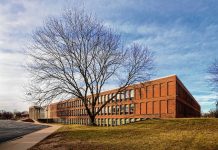Staff Reports
Exhibit Columbus, the annual exploration of architecture, art, design, has announced the five new design concepts commissioned for Washington Street in downtown Columbus.
The five Washington Street Civic Projects are part of the the 2019 exhibition, which will feature 18 total temporary installations from Aug. 24 to Dec. 1.
The works are designed by mission-driven organizations from across North America.
[sc:text-divider text-divider-title=”Story continues below gallery” ]Click here to purchase photos from this gallery
The Washington Street projects are being done by Borderless Studio (Chicago), Extrapolation Factory (New York), LA Mas (Los Angeles), People for Urban Progress (Indianapolis), and PienZa Sostenible (Mexico City).
Following the inaugural symposium in 2016 and a critically acclaimed exhibition symposium in 2017, Exhibit Columbus looked to the 1986 National Building Museum exhibition, “Good Design and the Community: Columbus, Indiana,” as a source of inspiration for its 2018-19 round of programming.
Created when the late Columbus businessman and philanthropist J. Irwin Miller became the first person inducted into the National Building Museum Hall of Fame, that exhibition honored the Miller family’s legacy of servant leadership and the entire city’s commitment to make Columbus the best community of its size.
This year, Exhibit Columbus explores the thematic concept of “good design and the community” in a tangible way by inviting architects, artists, and designers to create outdoor installations and experiences that use Columbus’-built heritage as context and inspiration.
In addition to the five previously announced design concepts by the J. Irwin and Xenia S. Miller Prize recipients and the six University Design Research Fellows, the Washington Street Civic Projects will showcase innovative work created by five leaders dedicated to using architecture, art, and design to improve people’s lives, connect communities and catalyze efforts to make cities more equitable and sustainable.
“The Washington Street Civic Projects provide a unique lens through which we hope to examine the notion of civic engagement through exhibition,” said Anne Surak, Exhibit Columbus’ director of exhibitions. “These innovative organizations use architecture and design as tools of collaboration to effect positive change in their own cities, and we are excited to have them develop temporary projects in our community.”
The 2019 Washington Street Civic Project Leaders are:
Love Letter to The Crump (Borderless Studio in Chicago): This project consists of a collective “love letter” showcased through a large-scale exterior curtain installation at The Crump. The letter will be written in the abstract –- a new graphic pattern inspired by Alexander Girard’s urban and textile design practices — and designed in collaboration with members of the community through participatory workshops where they will contribute to the creation of an abstract language inspired by the architectural features and character of the art deco theater. The project’s purpose is to invite both residents and visitors to reflect on the transformation process of places in Columbus. Foremost, Love Letter to The Crump aims to generate a dialogue about new forms and meanings for preservation.
Futures Kiosk (the Extrapolation Factory): Central to Extrapolation Factory’s methods of engagement are the creation of hypothetical future props and their deployment in familiar public contexts. Futures Kiosk will be installed on the sidewalk where Washington Street meets Second Street at an active corner that connects Columbus City Hall, the Bartholomew County Courthouse and Veterans Memorial, and The Republic Building. This installation, and its location at the heart of civic exchange, encourages members of the public to use the kiosk to contemplate, articulate and share future visions for Columbus. Each vision generated by members of the public, depicted as a short sentence and image, will be digitally shared with the mayor’s office with the intention that this database of visions offers decision makers inspiration and insight into the public’s desirable futures.
Thank U, Next (LA Más — Los Angeles): Partly an informal meeting space for the city, Thank U, Next is a study in contrast and will serve as a destination for people from all parts of the city and from all backgrounds to have shared civic experiences. This project thanks civic leaders and past architects for their highly formal contributions to Washington Street, but also looks to create the next precedent for an alternative. The project is an explicit and implicit invitation to working class residents to redefine Washington Street. The project also presents an urban plaza that is flexible, reconfigurable, playful, multiple, and open. It takes the form of a movable table that adapts to diverse programming, with that to be announced later.
Jungle Subtraction (People for Urban Progress in Indianapolis): By inserting a series of reflective panels and surfaces on public infrastructure along an entire city block of Washington Street, Jungle Subtraction will visually edit the pedestrian landscape. Trees, sign posts, light posts, bike racks, and trash cans will be covered in mirrored surfaces from chair height to door height, creating a reflective (subtracted) band along the street. Looking at the history of master planning of downtown Columbus, this project contemplates the point at which adding to a streetscape tries to fix something that isn’t broken. In consideration of Washington Street as a place of civic exchange, how can the exercise of subtraction help a Main Street be more Main Street in the future?
Las Abejas (PienZa Sostenible in Mexico City): This project includes deep research into the study of bees and beehives in an era of a declining bee population worldwide. In a model similar to the ReConstruir México initiative, the installation for Exhibit Columbus invites critically-acclaimed/internationally-renowned architects and Mexican designers to devise and build bee houses that encourage understanding of the importance of bees, while also contributing to increasing bee populations. Participants include TAX | Alberto Kalach, Tatiana Bilbao Studio, Rozana Montiel Arquitectos, and CC Arquitectos.
[sc:pullout-title pullout-title=”About the firms” ][sc:pullout-text-begin]
- Borderless Studio – Chicago: An urban design and research consultancy focused on shaping communities through collaborative design. The studio, led by Paola Aguirre, explores comprehensive city design solutions that address complex urban systems and equitable development, with emphasis on research and communication across disciplines and fields of practice.
- Extrapolation Factory – New York: The Extrapolation Factory is a design-based research studio for participatory futures studies, founded in New York by Chris Woebken and Elliott P. Montgomery. The studio develops experimental methods for collaboratively prototyping, experiencing and impacting future scenarios. With this work, the studio is exploring new territories for democratized futures by rapidly imagining, prototyping, distributing, and evaluating visions of possible futures on an extended time scale.
- LA Más – Los Angeles: a non-profit urban design organization, led by co-executive directors Elizabeth Timme and Helen Leung, that helps lower-income and under-served communities shape their own growth. LA-Más creates projects that are alternative models for development in neighborhoods that have been historically disinvested in and shut out of formal planning initiatives.
- People for Urban Progress – Indianapolis: a non-profit that advances good design and civic sustainability by developing products and projects that promote connectivity, responsible reuse, and making. With founder Michael Bricker as director of public design, PUP’s work is about rethinking the future of cities as it relates to the life cycle of its materials, matching these resources with existing community needs.
- PienZa Sostenible – Mexico City: a non-profit association that promotes the research, study, analysis, implementation, monitoring, and coordination on the current situation in Mexico. Led by architect Carlos Zedillo Velasco, PienZa Sostenible helped form ReConstruir México – an initiative that brings together architects and professionals to make knowledge and techniques available for the reconstruction of affected homes in vulnerable communities affected by the devastating 2017 earthquakes in the country. More than 40 distinguished architecture offices are now building 154 houses in seven of Mexico’s most damaged communities.
[sc:pullout-text-end][sc:pullout-title pullout-title=”About Exhibit Columbus” ][sc:pullout-text-begin]
The Exhibit Columbus exhibition is a once-every-two-years display of a wide variety temporary architectural installations meant to highlight or somehow connect to nearby, permanent structures and buildings in Columbus.
The exhibition is set for Aug. 24 to Dec. 1 and is an exploration of art, architecture, and design.
Exhibit Columbus seeks to celebrate Columbus’ heritage while making it relevant in new and modern ways, according to organizers. It is the signature project of Landmark Columbus, which was created in 2015 to care for the design heritage of Columbus, and is under the umbrella of The Heritage Fund — the Community Foundation of Bartholomew County.
To learn more, visit: exhibitcolumbus.org
[sc:pullout-text-end]




